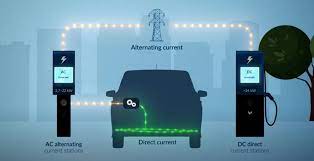The transition to electric vehicles (EVs) represents a monumental shift in automotive technology, driven by an urgent need for sustainable and efficient transportation options. The success of this shift hinges significantly on the advancements and accessibility of EV charging infrastructure. This article delves into the world of Alternating Current (AC) and Direct Current (DC) charging, providing a comprehensive overview of these technologies. We will explore the mechanics, benefits, challenges, and future prospects of AC and DC charging, offering insights into their pivotal role in the widespread adoption of electric vehicles.
As we embark on this exploration, it’s crucial to understand the basic mechanics of EV charging. AC charging, prevalent in residential and workplace settings, offers a convenient method for daily charging, while DC fast charging stations provide rapid charging ideal for longer journeys and commercial settings. The choice between AC and DC charging often hinges on various factors, including the vehicle’s capabilities, driver’s needs, and available infrastructure. This section aims to lay the foundation for a deeper understanding of these charging methods and their implications for the future of transportation.
The evolution of EV charging technology has been marked by continuous innovation and improvement. From the early, slow charging systems to today’s sophisticated, high-speed charging networks, the journey reflects a broader commitment to making electric vehicles a viable and attractive option for consumers worldwide. As we continue to push the boundaries of what’s possible, the charging infrastructure will undoubtedly play a critical role in shaping the future of electric mobility.
In navigating the complex landscape of EV charging, it’s essential for stakeholders, from consumers to policymakers, to understand the technical, economic, and environmental aspects of these technologies. By doing so, we can make informed decisions that accelerate the adoption of electric vehicles, reduce our carbon footprint, and drive us toward a more sustainable and efficient transportation future.
The Evolution of EV Charging Technologies
The history of EV charging is a testament to human ingenuity and the relentless pursuit of sustainability and convenience. From the early days of cumbersome and time-consuming charging to the current landscape of fast, efficient, and increasingly user-friendly systems, the evolution is marked by significant milestones and technological breakthroughs. This journey is not just about the chargers themselves but also about the broader ecosystem, including power generation, grid management, and user interfaces.
Innovation in charging technology is driven by the need for speed, convenience, and integration. Today’s chargers are faster, smarter, and more adaptable than ever before, featuring capabilities such as dynamic load management, solar integration, and wireless charging. The development of ultra-fast DC charging stations is particularly noteworthy, reducing charging times dramatically and making EVs more appealing for a wider range of applications and users.
However, the evolution of charging technology is not without its challenges. Issues such as grid capacity, standardization, and interoperability present significant hurdles. Additionally, as the demand for EVs continues to grow, the need for widespread and accessible charging infrastructure becomes more acute. Addressing these challenges requires coordinated efforts from industry stakeholders, policymakers, and consumers, as well as continued investment in research and development.
As we look to the future, the prospects for EV charging technology are bright. Ongoing advancements in battery technology, the integration of renewable energy sources, and the development of smart grid capabilities are set to further enhance the efficiency and convenience of EV charging. These innovations will not only benefit EV users but also contribute to the broader goals of reducing greenhouse gas emissions and building a more sustainable and resilient transportation system.
Navigating the AC and DC Charging Landscape
Understanding the landscape of AC and DC charging is crucial for navigating the world of electric vehicles. AC charging, typically used for overnight home charging, offers the benefits of convenience and widespread availability. Most EVs come equipped with onboard chargers that convert AC electricity from the grid into DC electricity for the battery, making AC charging the standard for daily use.
In contrast, DC charging represents the fast-charging solution needed for longer journeys and quick top-ups. DC chargers supply power directly to the battery, bypassing the onboard charger and significantly reducing charging time. This method is ideal for public and commercial settings where time is of the essence. However, the higher costs associated with DC charging infrastructure and the need for more powerful grid connections make it less common than AC charging.
Choosing between AC and DC charging often depends on individual needs and circumstances. For most daily commuters, AC charging at home or work is sufficient and cost-effective. For those who travel longer distances or need a quick charge, DC fast-charging stations are more appropriate. Understanding the availability, cost, and speed of these charging options is key to making informed decisions and ensuring a seamless EV experience.
As the EV market continues to grow, the charging landscape is becoming more complex and diverse. New technologies and business models are emerging, offering more options and flexibility for EV users. From subscription-based charging services to mobile charging solutions, the ways in which we charge our electric vehicles are evolving rapidly. Staying informed and adaptable is essential for both new and seasoned EV users as they navigate this dynamic and rapidly changing landscape.
The Economics of EV Charging
The economics of EV charging is a critical factor influencing the adoption and use of electric vehicles. The cost of charging an EV can vary widely depending on several factors, including the type of charger used, the price of electricity, and the charging location. AC charging at home is generally the most cost-effective option, especially when charging overnight during off-peak hours. In contrast, using public DC fast-charging stations can be more expensive due to the higher costs associated with the equipment and the electricity used.
To encourage the adoption of EVs and the development of charging infrastructure, governments and utilities often offer incentives and rebates for home charger installation and use. These incentives can significantly reduce the upfront costs of acquiring and installing an EV charger, making it more affordable for consumers. Additionally, some utilities offer special rate plans for EV owners, providing lower rates for electricity used to charge electric vehicles.
However, the economics of EV charging is not just about the cost to the consumer. It also involves the broader economic impact of transitioning to electric vehicles, including the effects on the energy sector, job creation, and environmental benefits. The growth of the EV market and the associated charging infrastructure can stimulate economic development and create new opportunities for businesses and workers.
As the EV market continues to evolve, so too will the economics of EV charging. Advances in technology, changes in energy markets, and shifts in consumer behavior will all play a role in shaping the cost and availability of EV charging. By understanding these dynamics, consumers, businesses, and policymakers can make more informed decisions and help ensure a smooth and successful transition to electric transportation.
The Role of Technology and Innovation in EV Charging
Technology and innovation are driving the evolution of EV charging, making it faster, more convenient, and more accessible. Advances in charging technology, such as ultra-fast DC charging and wireless charging, are reducing the time it takes to charge an EV, making electric vehicles more practical for a wider range of uses. Smart charging systems, which optimize charging based on factors such as electricity prices and grid demand, are helping to make EV charging more efficient and cost-effective.
Innovation in charging infrastructure is also playing a key role in expanding the availability and accessibility of EV charging. New business models, such as charging-as-a-service and mobile charging solutions, are providing more options for EV users, especially in areas where traditional charging stations are not available. Additionally, the integration of renewable energy sources into charging infrastructure is making EV charging more sustainable and helping to reduce the carbon footprint of electric transportation.
The ongoing development of battery technology is another critical aspect of EV charging innovation. Improvements in battery capacity, charging speed, and lifespan are enhancing the performance and reducing the cost of electric vehicles. At the same time, advances in battery recycling and second-life applications are addressing some of the environmental and resource challenges associated with EV batteries.
As technology and innovation continue to advance, the future of EV charging looks promising. With continued investment in research and development, collaboration among industry stakeholders, and supportive policies and incentives, the possibilities for improving and expanding EV charging are vast. By embracing innovation and technology, we can accelerate the transition to electric transportation and realize the full potential of electric vehicles.
Consumer Considerations and the Future of EV Charging
For consumers considering an electric vehicle, understanding the ins and outs of EV charging is essential. The choice of charging method, the availability of charging infrastructure, and the cost of charging are all important factors to consider. Consumers need to assess their driving habits, vehicle needs, and available charging options to determine the best approach for their situation. Educating themselves about the different types of chargers, charging speeds, and connector types can help consumers make informed decisions and ensure a positive EV experience.
The future of EV charging is likely to be characterized by greater convenience, accessibility, and integration. As charging technology continues to advance, we can expect to see more widespread adoption of fast charging, wireless charging, and smart charging systems. The integration of EV charging with smart homes and smart grids will provide even more options and flexibility for consumers, allowing them to charge their vehicles in the most efficient and cost-effective way possible.
The growth of the EV market will also drive the expansion of charging infrastructure, with more public charging stations being installed in a variety of locations, from urban centers to rural areas. This expanded infrastructure, along with continued innovation in charging technology, will help to alleviate range anxiety and make electric vehicles a practical choice for more people.
However, realizing the full potential of EV charging and electric transportation will require continued collaboration among industry stakeholders, supportive policies and incentives from governments, and ongoing education and engagement with consumers. By working together, we can overcome the challenges and seize the opportunities presented by this exciting and evolving market.
Innovating the Charging Experience
In the dynamic world of EV charging, innovation is not just about creating faster or more efficient chargers; it’s about rethinking the entire charging experience. ChargeTronix exemplifies this movement with its commitment to designing a range of both AC and DC charging solutions tailored for a diverse clientele across North and Latin America. Their products are distinguished by their modular, robust, and powerful design, engineered for maximum functionality and uptime. The latest models feature innovative distributed designs, including power cabinets capable of energizing multiple dispensers, reflecting the company’s commitment to intelligent and adaptable charging solutions.
The industry’s shift towards enhanced user experience and sustained engagement is evident in how companies prioritize customer interaction and satisfaction. Recognizing that the purchase of an EV charger is a significant investment, these firms offer extensive support and educational resources to ensure a comprehensive understanding and ease of use for their products. Strategic alliances with technological innovators and service providers underscore the industry’s commitment to continual improvement and leadership in the EV charging space.
Adaptability and customization are the hallmarks of modern EV charging solutions, with a focus on meeting the specific needs of diverse user bases. Companies are increasingly offering a variety of features such as integrated payment systems, user-friendly interfaces, and flexible power management options. This approach not only caters to the immediate needs of users but also anticipates future trends and changes in the EV landscape, ensuring longevity and relevance in a rapidly evolving market.
As the EV market continues to expand, the role of innovative companies in shaping its trajectory is undeniable. Their relentless pursuit of quality, efficiency, and customer satisfaction is setting new standards for the industry. The emphasis on durable, customizable, and user-oriented products and services is driving the EV charging sector towards a more efficient, convenient, and sustainable future. These companies are not merely selling products; they are offering a gateway to a more environmentally conscious and technologically advanced mode of transportation.
Embracing the Charge Towards a Sustainable Future
The journey towards widespread adoption of electric vehicles is inextricably linked to the evolution and accessibility of EV charging. As we have explored, the worlds of AC and DC charging are complex and multifaceted, encompassing technical, economic, and consumer considerations. The continued growth and development of the EV market will depend on our ability to address these considerations and provide efficient, convenient, and affordable charging solutions.
Innovation and technology will play a critical role in shaping the future of EV charging, driving advances in speed, convenience, and sustainability. Consumers, for their part, will need to stay informed and adaptable as the charging landscape continues to evolve. And policymakers and industry stakeholders will need to work together to support the growth of the EV market and the development of the charging infrastructure it requires.
As we look to the future, the prospects for EV charging are bright. With continued progress and collaboration, we can look forward to a world where electric vehicles are the norm, supported by a robust and accessible charging network. Embracing the charge towards a sustainable future, we can reduce our carbon footprint, improve our quality of life, and create a cleaner, greener world for generations to come.
This article aims to provide a closer look at AC and DC charging for EVs, offering a comprehensive understanding of the technologies, challenges, and opportunities that lie ahead. As we continue to navigate this exciting and rapidly evolving landscape, let us remain committed to innovation, collaboration, and sustainability, driving forward towards a brighter, electric-powered future.
Write and Win: Participate in Creative writing Contest & International Essay Contest and win fabulous prizes.
















